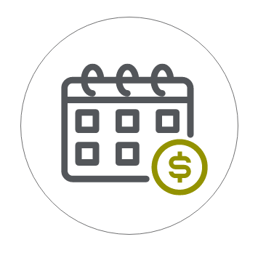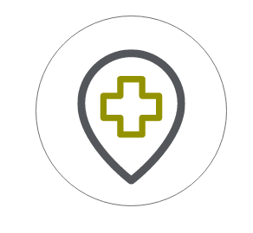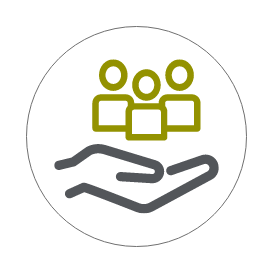Table of Contents
Learn how a comprehensive patient experience strategy can enhance patient satisfaction, retention rates, and hospital reputation and put a plan into action.
Improving patient engagement and communication throughout the revenue cycle process is essential for healthcare providers aiming to transition from a fee-for-service model to one that offers value-based care. This transition can be a challenging one for healthcare administrators and leaders alike. But there are some key strategies to employ that can make this process more seamless. With these actionable steps, it is possible to optimize revenue and manage the transition efficiently.
To start, healthcare providers must prioritize three critical elements
Patient comprehension:
Patients need to fully understand their health and treatment plans so they can take an active role in their care.

Financial communication:
Healthcare providers and patients should have an open dialogue regarding the cost of care. This can include payment options and financial assistance programs to help ensure accurate billing and efficient administration.

Payment options:
Patients should be aware of the payment options available to them. This can include insurance coverage, out-of-pocket expenses, and financial assistance programs. Since billing and insurance claims can confuse many patients, this is a crucial step.

Since many patients have health plans with a high-deductible, it becomes necessary to collect payments for their care. But as many healthcare leaders know, this presents a serious challenge to the organization. Initiating meaningful discussions about financial responsibility have become a task that keeps many healthcare billing leaders up at night.
To meet these challenges, healthcare providers need to identify payer sources and find ways to initiate conversations with patients about their financial obligations. Adding greater convenience to the process, from including online payment options for patients and customer service support can lead to better patient engagement and improved revenue cycles.

Key Challenges in Patient Engagement and Communication
Key Challenges in Patient Engagement and Communication
Billing Transparency
The biggest complaint for most patients: a lack of billing transparency and clarity. Some of the most common questions patients want answers for include:

What are my out-of-pocket
costs?

Are there any payment plans?

What kind of insurance do I
have to use?
Patients often feel overwhelmed and confused by the lack of easily accessible or understandable answers to these questions. If they receive an unexpected bill that isn’t easy to understand, this can exacerbate their confusion and anxiety. If a patient sees multiple providers, each sending a bill, this can further complicate the process for patients.
It’s no surprise that patients become frustrated and stressed by such billing. They may need help understanding the language providers use to describe the various services listed on their bill and their associated costs. In addition, language can present another barrier to communication, with providers finding it even more of a challenge to attempt a discussion of financial responsibility when patients have limited English proficiency.

Blocks in Communication and Convenience
Another challenge is the need for more connection with patients. Time-crunched hospital and clinic staff often focus entirely on collecting payments, rather than explaining the details of a bill and payment options. These interactions can then leave patients frustrated and disengaged. That’s why it’s so important for providers to create meaningful interactions with the patient, their family or caregiver, to ensure they are heard, understood, and respected.
Finally, patients are busy and demand convenience when it comes to bill paying. Consumers increasingly use online payment platforms, make payments using their mobile devices, or even use other forms of digital finance. Healthcare organizations must keep up with the ever- changing landscape of bill payment technology or risk being at a significant disadvantage.
To remain competitive, providers need to offer easy-to-use payment solutions that meet the needs of their patients while providing flexible options for financing their medical care. Health plans can also help to lower out-of-pocket costs by allowing consumers to pay a portion of their medical bills through monthly installments. Being mindful of patient financial policies and processes is essential in providing quality healthcare services while maximizing patient satisfaction.

Strategies for Improving Patient Engagement and Communication in the Revenue Cycle Process
While there are numerous challenges patients encounter in regard to their medical bills, there are steps providers and healthcare organizations can take to improve outcomes. Here are some essential strategies for improving patient engagement and communication in the revenue cycle process.
Provide Patients with Cost Estimates
Patients are better informed and more prepared to pay their medical bills when they have cost estimates of services or approximations of their out-of-pocket expenses. This allows them to make more informed decisions. Sharing resources, like estimation tools can empower patients with cost figures before care is received and allow for the arrangement of payment plans. These steps can help improve affordability for patients and better position providers for more efficient payments.
Offer Financial Counseling
Financial counseling can bridge the gap between a patient and unpaid bills. This begins with an accurate treatment plan, which can help empower a patient to feel more confident in their care. This process should include clear explanations of charges, billing policies, insurance coverage and copay options, which can give the patients the necessary financial data to make more informed decisions about their care.
For those who are financially limited, financial counselors can help navigate hurdles from housing to transportation and assist in affording copays. For healthcare organizations, this can extend to collaborations between direct care teams and community organizations, to help meet additional patient needs.
Utilize Online Patient Portals
Online portals give patients the access they need to the information whenever they would like to review them. This 24/7 convenience provides a secure way for patients to access their medical records, communicate with health providers, track their health data, review lab results, pay bills, and more — all in one place.
This virtual approach can of course extend to more cost-effective care opportunities as well. Healthcare technology engagement tools such as telemedicine, e-visits and self-triage services can help reduce costs for providers while reducing wait times for patients. Family members can also be engaged in the process, making monitoring a loved one remotely possible. Patients also have quick access to lab results, visit notes and radiology reports via a self-service portal, all value-additions that help streamline care and give patients more information in less time.

Use Preferred Communication Options
When it comes to communication, it’s essential to meet patients where they are. Obtaining their communication preferences early on in the provider-patient relationship helps foster more effective communication. After all, why incur the cost of mailing if patients prefer email or text? Do they have a specific time of day when they are more available than other times? Not everyone works a 9-5 job, so some patients may not be available in the evening, while others may not want to be called during traditional business hours. Asking questions on patient contact form such as preferred times and days for call at the onset of the relationship can eliminate wasted resources on unfruitful contact methods.
Use Text Message Reminders
Mobile devices have become a constant companion in our lives today, with SMS messaging becoming one of the most direct ways to reach anyone at any time. For healthcare providers, text message reminders provide a direct link to their patients, improving healthcare outcomes by ensuring patients are informed and up-to-date on their appointments (potentially avoiding unnecessary missed appointment charges) and receiving instant prescription refill reminders and follow-up care information. Additional uses include:

Health check-ins

Appointment rescheduling

Automated billing
and payment reminders

Lab report updates

Surveys and
feedback reminders
Engage Care Managers
Care managers, such as nurse practitioners, physician assistants and clinical nurse specialists, play a crucial role in engaging patients before and during their healthcare journey. Their involvement can not only expedite care, but make it more cost-effective for patients as well. Before their first appointment, care managers prepare patients by assigning paperwork to be completed beforehand, ensuring more time spent with providers.
During treatment, care managers can create patient-specific campaigns and identify those at a higher risk for adverse events. They also proactively engage with patients through multiple channels to assess their health holistically, avoiding unnecessary hospital visits, ensuring that families are engaged and informed and acting as a liaison to streamline access to a provider’s technology platform.

Best Practices for Patient Engagement and Communication in the Revenue Cycle Process
Taking a tailored, patient-centric approach to the revenue cycle process can significantly impact patient engagement and ultimately lead to improved revenue cycles.
Establish open communication channels:
Provide multiple options for patients to contact your organization, such as phone, online chat, email and text. These channels should be monitored regularly and staff should respond to inquiries quickly, even if the answer is simply that the inquiry is being looked into.
Leverage patient feedback:
Include patient satisfaction surveys delivered via email or online patient portals. Digital tools such as chatbots can also help collect feedback quickly and efficiently. Analyzing this feedback can help identify patient pain points and areas that need improvement. This allows for proactive interventions that directly address patient needs.
For example, if patients commonly report frustration with long wait times on the phone or confusion about billing statements, the revenue cycle team can take action to alleviate these issues and create a more positive patient experience.

Train staff to communicate effectively with patients:
Improving communication skills can create a more positive patient experience when dealing with financial matters. Staff training should incorporate financial literacy and training on how to properly explain the nuances of insurance payments. Staff should also be educated on how to provide cost estimates, along with strategies for effectively negotiating with patients.
Staff should be encouraged to proactively address patient concerns, rather than putting them off until a later time. For example, if a patient expresses concern about their ability to pay, the staff can offer potential payment options right then and there, rather than directing them to a different department which requires them to start the process over again.

Stay up-to-date on regulations:
Be aware of changing laws and regulations, such as the Health Insurance Portability and Accountability Act (HIPAA) or the Fair Debt Collection Practices Act (FDCPA), to ensure billing and collection compliance.
Ensure patient data is secure:
Investing in the latest security measures to protect patient data is essential for a successful revenue cycle management process. Educate staff on how to protect patient data and regularly review security protocols. Make certain that online payment portals are set up to securely receive sensitive payment information.
Take a more patient-centered care approach:
Continuously encourage staff to provide patients with a more personalized experience, particularly when it comes to billing and collections. Creating and offering flexible payment options that can be customized to a patient’s individual needs is key to making them feel understood and respected.
Improving communication with patients isn’t a one-time fix. It’s a continuous multi-faceted process that builds a bridge between patients and a revenue cycle. By making the necessary changes and following these best practices, providers can help empower patients to feel in better control of their care, which in turn will improve their engagement with the provider’s revenue cycle process.

 By
By 
